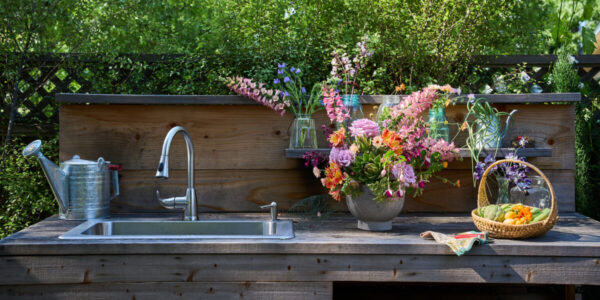
Good earth
Your garden soil is like your bank account: In the long run, you can’t afford to withdraw more than you deposit. Whenever you harvest fruits, vegetables, or flowers, you’re making withdrawals. Whenever you dig amendment into the soil or add mulch to the surface, you’re making deposits. Organic amendments ― compost and rotted manure, for example ― fatten up the soil bank. They rejuvenate poor soil, allow excess water to drain away while leaving enough moisture for roots, and retain nutrients until feeder roots need them.
Now, before spring planting, is a good time to enrich the soil for robust flowers and vegetables later this year. Keep in mind that beds for most trees, perennials, and native shrubs and groundcovers don’t need to be amended unless soil is sand or heavy clay. Just till and plant.
What to use and how to use it
A mix of composted grass clippings, leaves, and tree prunings is ideal for most flower and vegetable beds. Use your shovel or rent a rotary tiller to mix a 2- to 4-inch layer of organic amendment into the top 8 to 12 inches of soil.
When installing a new garden on a site that has been bulldozed down to the subsoil or compacted by heavy equipment, you’ll need lots of soil amendments ― perhaps even a fresh layer of topsoil ― before planting. Hire a tractor to amend large areas. In established gardens, amend planting beds before setting out the following:
• Acid-loving plants like blueberries and rhododendrons. Use peat moss, especially if the pH of your native soil is above 6 (a soil test kit can tell you).
• Annual flower and vegetable beds. A small tiller makes the work go quickly.
• Blackberry, raspberry, and strawberry beds. They should be amended before initial planting, then again every few years when they’re torn out and replanted.
• Lawns. Amend sandy or heavy clay soil with sifted commercial compost before you lay sod.
How much to buy
A small pickup truck holds about 1 cubic yard (5 contractor wheelbarrow loads), and a large pickup about 1 ½ cubic yards. Landscape supply companies will deliver bulk orders. Nurseries also sell bagged compost.
For a 100-square-foot plot:
2-inch amendment layer requires 2/3 cubic yard
3-inch amendment layer requires 1 cubic yard
4-inch amendment layer requires 1 ¼ cubic yards
For a 250-square-foot plot:
2-inch amendment layer requires 1 2/3 cubic yards
3-inch amendment layer requires 2 1/3 cubic yards
4-inch amendment layer requires 3 ¼ cubic yards
For a 500-square-foot plot:
2-inch amendment requires 3 ¼ cubic yards
3-inch amendment requires 4 1/3 cubic yards
4-inch amendment requires 6 ¼ cubic yards
For a 1,000-square-foot plot:
2-inch amendment layer requires 6 ¼ cubic yards
3-inch amendment layer requires 9 ¼ cubic yards
4-inch amendment layer requires 12 ½ cubic yards
